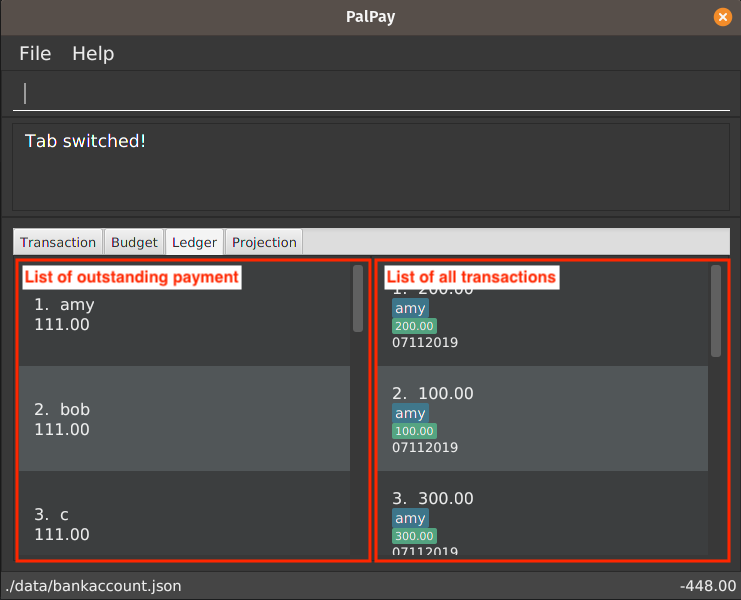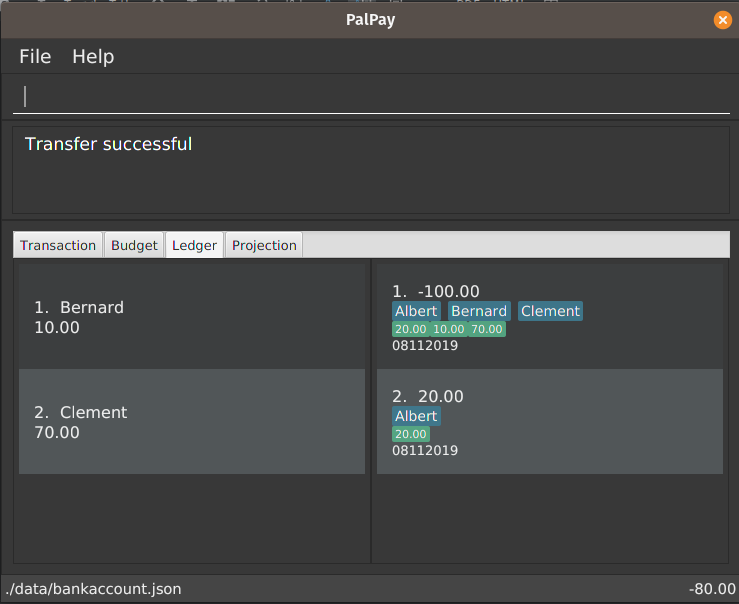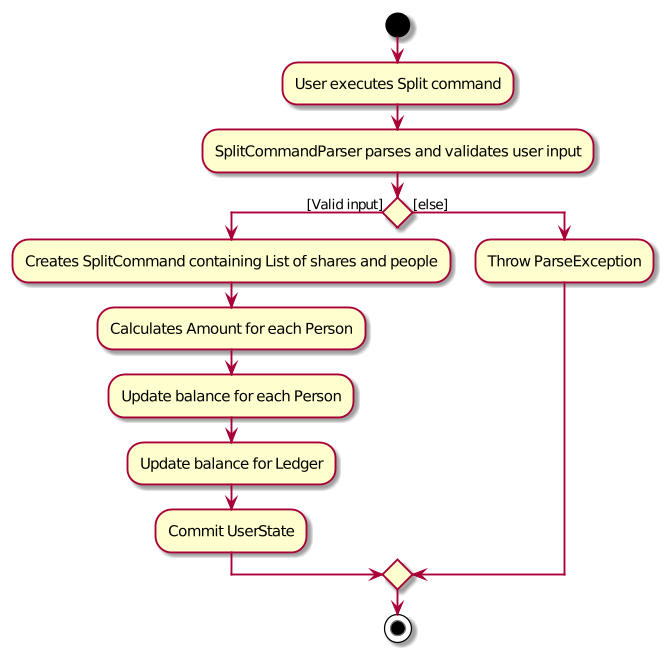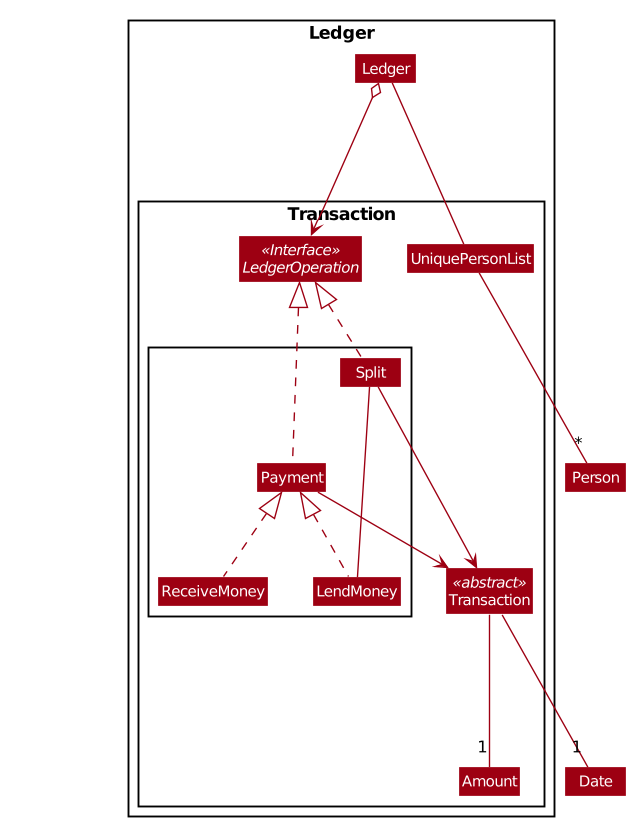1. Overview
This portfolio documents my contributions to PalPay, a software engineering project under the module, CS2103T Software Engineering. PalPay is an expenditure tracking application. The user interacts with it using a CLI, and it has a GUI created with JavaFX. It is written in Java, and has about 10 kLoC
For the project, my main role was to implement the Split features, which allow the user to record when bills are split between friends and when they settle up.
2. Summary of contributions
-
Code contributed: RepoSense
-
Major enhancement: Implemented the
Ledgertab and functions associated with it.-
What it does:
-
Allow user to split a bill easily between people. This can be by shares, or evenly, with or without including the user.
-
Allow individuals to settle up.
-
-
Justification: In our target demographic, many express that keep track of transactions between friends. Our application aims to solve this pain point by providing a simple way to keep track of debts.
-
Highlights: The
Ledgertab has a split screen user interface, for the user to keep track of unpaid dollars and each transaction recorded between friends. TheLedgerwill only display people with outstanding balances on the left side of the screen, while transactions are listed on the right. (See below)
-
-
Minor enhancement: added checks and improved error messages for handling
Amount. -
Other contributions:
-
Project management:
-
Enhancements to existing features:
-
Refactor
Transactionsinto Operations, such that theModelcan be overloaded to achieve polymorphism. (Pull requests: #95) -
Refactor
VersionedBankAccountintoVersionedUserStatethat allows for the integration of theLedgerclass, without associating the balances ofBankAccountandLedger. (Pull request: #133) -
Wrote comprehensive unit test cases for the
SplitandReceivecommmands and parsers. (Pull requests: #70, #114, #202, #205)
-
-
Documentation:
-
Reformatted the User Guide for a more sequential flow.
-
Wrote the details for the following commands in the User Guide.
-
Split
-
Receive
-
-
Created UML diagrams to help in the explanation of
splitandreceivecommands in the Developer Guide.
-
-
Community:
-
Reported bugs and suggestions for other teams in the module. (Examples: T14-2 #194, T14-2 #195, T12-4 #208, T12-4 #207, T12-4 #202 )
-
-
3. Contributions to the User Guide
Given below are sections I contributed to the User Guide. They showcase my ability to write documentation targeting end-users. |
3.1. Splitting a Bill with Friends : split
Split a bill with your friends
Format: split $/AMOUNT n/NAME1 a/DESCRIPTION [d/DATE] [n/NAME2]… [s/SHARE]…
-
DESCRIPTIONis prefixed witha/, unlike for other commands -
[SHARE]defines portion of bill to be paid by each person-
if no shares are given,
AMOUNTwill be split evenly across all people, including user -
you are included in the bill if number of shares is 1 more than number of people
-
your share of the bill will be the first listed share
-
-
each person’s share is assigned in order
-
i.e. last person’s share is the last share listed
-
-
| Shares can be 0 but result is not guaranteed to be meaningful |
Ledger GUI

This is how the Ledger looks when you switch to the splits tab.
The left shows the people who has unresolved balances with you, while the right lists
all transactions that have to do with the Ledger.
Ledger's balance is separate from PalPay’s balance. It is displayed in the same position,
at the bottom right corner.
split does not include how much you spent into the Ledger balance.
|
3.1.2. Example Usage
-
split $/1000 n/Amy n/Betty n/Catherine n/Dan a/haidilao$1000 is split equally between Amy, Betty, Catherine, Dan and the user.
-
Enter appropriate command into the command line.
 Figure 2. Input for Splitting Evenly
Figure 2. Input for Splitting Evenly -
Result is displayed accordingly
 Figure 3. Amy, Betty, Catherine and Dan owes $200 each
Figure 3. Amy, Betty, Catherine and Dan owes $200 eachFor an even split of $1000, each person pays $200. Therefore Ledger shows $200 on the tab of each person. Ledger balance does not include how much you spend. In this bill, one is owed $800 in total from the rest of his friends. Therefore Ledger balance is -$800, as shown in the bottom right.
-
-
split $/100 n/Albert n/Bernard n/Clement s/2 s/1 s/7 a/kbbq dinner$100 is split with Albert owing $20, Bernard owing $10 and Clement owing $70.
-
Enter appropriate command into the command line.
 Figure 4. Input for Splitting Unevenly
Figure 4. Input for Splitting Unevenly -
Result is displayed accordingly
 Figure 5. Display of Correctly Assigned Amounts
Figure 5. Display of Correctly Assigned AmountsSince the number of shares is equal to the number of people listed, you are not included in the splitting of the bill.
-
3.2. Receiving Money from a Friend : receive
Receives money from a friend
Format: receive $/AMOUNT n/NAME1 [d/DATE] [a/DESCRIPTION]
3.2.1. Example Usage
-
receive $/20 n/AlbertTransfers $20 from Albert to user. If Albert is no longer owe or is owed money, he will be removed from the Ledger.
-
Enter appropriate command into the command line.
 Figure 6. Input for Receiving $20 from Albert
Figure 6. Input for Receiving $20 from Albert -
Result is displayed accordingly.
 Figure 7. Result of Payment from Albert
Figure 7. Result of Payment from AlbertAlbert is removed from the Ledger since he no longer owes any money. Ledger balance is also updated accordingly.
-
4. Contributions to the Developer Guide
Given below are sections I contributed to the Developer Guide. They showcase my ability to write technical documentation and the technical depth of my contributions to the project. |
4.1. Split Feature: split
This feature allows the user to pay for a certain item or make a transaction on behalf of his friends. Refer to the UserGuide for usage details.
4.1.1. Current Implementation
The split command is an abstraction of LendMoney class.
Given a list of shares and people, each person is assigned an amount based on the corresponding positional share and the total amount given to split command.
A LendMoney instance is created for each person and executed.
Below shows how a typical command from the user is executed by the program.

SplitCommandStep 1: User enters split $/200 n/a n/b n/c a/desc into the command line to split $200 among a, b and c.
Step 2: Upon executing the command, LogicManager uses MainParser#parse() to parse the input from the user.
Step 3: MainParser determines that user input is an instance of a SplitCommand and creates a SplitCommandParser
to further parse the input.
Step 4: SplitCommandParser parses the command and checks if fields like amount and names are valid.
If all fields are valid, it returns a SplitCommand. Else, an error is thrown to the result box and the execution
terminates.
Step 5: LogicManager uses SplitCommand#execute() to update the balances of Ledger and people involved in the
transaction.
Step 6: SplitCommand#execute() calls Model#add() to add the user input into the user history.
Within the function call, the actual update of balances is handled in Ledger#handleOperation().
Step 7: SplitCommand calls Model#commitUserState() after executing to save the latest state of the application.
Step 8: A CommandResult is then returned to the LogicManager which is then displayed to the user.

Split Object4.1.2. Design Considerations
Below shows how the classes involved with Ledger interact with each other.

Current implementation of Split class encourages code reuse by abstracting the delegating the task of rebalancing to another class.
However, this introduces coupling as the behavior of Split is now inexplicably tied to LendMoney.
4.2. Settle Up Feature: receive
This feature allows another person to send money to the user.
The balance in the Ledger and the balance of the sender is updated accordingly.
4.2.1. Current Implementation
The receive command creates ReceiveMoney class that handles the transfer of fund from another person to the user.
How receive relates to the rest of the Ledger classes can be inferred from the
class diagram above.
In the handleBalance method of ReceiveMoney, it will find the correct person in the Ledger by name,
or create a new Person with given name if it is not already in the Ledger.
Balance of the user and the sender is then updated accordingly.
Below is an example usage scenario for how receive would behave.
Step 1: User enters receive $/200 n/a into the command line to settle up $200 from a.
Step 2: Upon executing the command, LogicManager uses MainParser#parse() to parse the input from the user.
Step 3: MainParser determines that user input is an instance of a ReceiveCommand and creates a ReceiveCommandParser
to further parse the input.
Step 4: ReceiveCommandParser parses the command and checks if fields like amount and names are valid.
If all fields are valid, it returns a ReceiveCommand. Else, an error is thrown to the result box and the execution
terminates.
Step 5: LogicManager uses ReceiveCommand#execute() to update the balances of Ledger and the person in the
transaction.
Step 6: ReceiveCommand#execute() calls Model#add() to add the user input into the user history.
Within the function call, the person in Ledger is found and his/her outstanding balance is updated in Ledger#handleOperation().
If he is not already inside the Ledger, a new Person is created with the same name.
Step 7: SplitCommand calls Model#commitUserState() after executing to save the latest state of the application.
Step 8: A CommandResult is then returned to the LogicManager which is then displayed to the user.
handleBalance in ReceiveMoneypublic class ReceiveMoney extends Payment {
@Override
public Amount handleBalance(Amount balance, UniquePersonList peopleInLedger) {
Person target = super.handleTarget(peopleInLedger);
target.spend(amount);
return balance.addAmount(amount);
}
}
public abstract class Payment extends Transaction implements LedgerOperations {
protected Person handleTarget(UniquePersonList peopleInLedger) {
Person personInvolved = person;
if (peopleInLedger.contains(person)) {
personInvolved = peopleInLedger.get(person).get();
} else {
peopleInLedger.add(person);
}
return personInvolved;
}
}